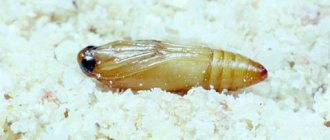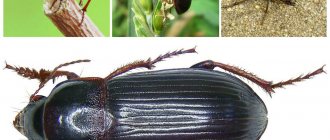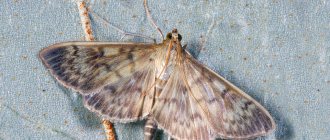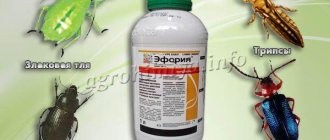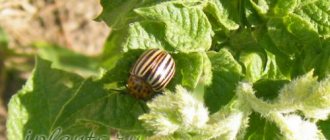Description of the pest
Weevils are from the order of coleopteran insects of the family Curculionidae, of which there are more than 70,000 species in the world. This pest lives in most countries of Europe, the northern part of the African continent, Central Asia and the European part of Russia. Beetles have learned to adapt to any climate and survive well even in unfavorable conditions. Representatives of this family differ in appearance and food preferences. Common and gray beet weevils are more common in vegetable gardens and agricultural lands. Each type has common and distinctive features that you should know about:
| Criteria | Common beet weevil | Gray beet weevil |
| Other name | Bothynoderes punctiventris, Sugar beet weevil, Cleonus punctiventris, popularly known as beetle beetle or elephant beetle. | Tanymecus palliatus, gray polyphagous weevil, sainfoin weevil, popularly gray beet elephant. |
| External structure | Body size 10-17 mm. The black body is covered with thick grayish scales and hairs, a broken line runs down the center, and there are 2 light scaly spots at the back. The gray belly is mottled with dark spots. Large eyes are located on the sides, the antennae are geniculate with a club-shaped ending, the small rostrum is covered with many grooves. The elytra have a rounded shape, with well-developed wings located underneath them. | Body length is 9-12 mm. The color is uniform without inclusions. The beetle's body is covered with brownish hairs and gray scales. In the region of the elytra there are humeral tubercles. The wings are underdeveloped. The mustache is also club-shaped and multi-jointed. |
| Sex differences | The female individual is larger, the last section of the legs is less covered with hairs. Males are distinguished by their smaller size, the presence of a longitudinal dent on the abdomen, and the growths at the end of the antennae are slightly larger than those of females. | |
| Reproduction and development | Beetles actively mate in spring from the second half of April to the end of May. Depending on weather conditions, the female lays from 30 to 300 eggs in the ground near the beet crops. In 85 days, the insect goes through all stages: egg - larva-pupa - imago. | During the mating season, the female lays up to 700 eggs; the clutch size depends on the food crop. It takes 12-25 months from the larval phase to the imago. In autumn, adult insects mostly die, and the larvae go deep into the ground. |
| Lifestyle | For the winter, the beetle burrows into the soil up to half a meter deep. When warming reaches 5-7C˚ it comes out of diapause. When the temperature reaches above 22C˚, they begin to fly away over long distances. They are active during the daytime. | Not only adults, but also larvae are preparing to spend the winter. They bury themselves to a depth of 30 cm. They wake up later than other pests, when the soil warms up to 10 C˚. Activity occurs in dry sunny weather. Due to underdeveloped wings, the beetles move on the surface of the soil, and the larvae move underground. |
| Nutritional Features | This species is monovorous - it feeds on one crop, namely all types of beets. Before the beet shoots appear, the weevil makes do with weeds like quinoa or knotweed. After germination, beets prefer to feed on it: the larvae gnaw through the lateral and main roots, the root crop itself, and the adults eat the leaves. | Gray weevils are polyvorous and can feed on several crops. In addition to beets, they eat peas, onions, garlic, sorrel, sunflowers, potatoes, grapes, corn and wild herbs. |
Many people confuse another type of beetle with the beetle beetle due to some similarity in name and external features. However, the gray bud weevil (Sciaphobus squalidus Gyll), despite its polyphagous nature, prefers to feed on leaves, buds and flowers of fruit trees and shrubs. It is smaller in size (5-7 mm), the body has a grayish-pink color, and the antennae and paws are yellow.
Stages of reproduction
Adult insects overwinter in the fields, waking up when the air temperature reaches a stable three to four degrees Celsius. When the air warms up to +13...+17 °C, the beetles take wing and go on a migration in search of legumes, which lasts about ten or fifteen days.
Having fed up after the winter, the females begin to lay eggs in May and continue this activity until July, after which they die from exhaustion. One female can lay from 90 to 900 eggs per season (the number depends on weather conditions and nutrition).
Eggs are laid chaotically, without any preparation in the form of being buried in the ground. The sticky egg that ends up on the stem or leaf, after drying, simply rolls onto the ground, with which it mixes after the rain. If the air temperature is above thirty and there is no rain, the embryo dies.
The development of an embryo that finds itself in favorable conditions at a temperature of 25 °C lasts about a week, after which the hatched larvae settle in nodules, which they subsequently feed on. After a couple of tubers are eaten, the larva grows and feeds outside, also eating the roots of the plants. Growth continues for a month, after which the larvae, having gained the required mass, dig a cradle in the ground, the walls of which are cemented with saliva and earth. The cradle is easily destroyed during excavation, but when left intact it allows the soft pupa to develop into a young beetle in a few days.
Why is it dangerous?
If the common weevil attacks only beet crops, then more types of garden plants may suffer from the gray weevil. Not only adult insects, but also their larvae damage crops. Adults feed on leaves, gnawing them to the ground. The larvae damage crops underground, eating roots and root crops. Subsequently, specimens damaged by the beetle die. The beets need to be sown again. Surviving plants are deformed, their roots gain weight poorly and contain less sugar, and the number of ripened seeds decreases.
Harm of weevils to agriculture
The common beet weevil is not liked because it damages plantings of mainly various types of beets, since adult beetles eat the young plant down to a stump. In general, adult weevils can destroy even young deciduous plantings of oaks and lindens.
The beetles are replaced by larvae, damaging already sufficiently developed root systems of plants. The result is easy to predict: the plants dry out and eventually die. Considering that contaminated soil can contain up to three to four beetles per square meter, the scale of the disaster is not difficult to imagine.
As a species, the African bee arose as a result of a scientific experiment. There are various home remedies for ear infections. The most effective are sprays, and the safest are adhesive tapes. Descriptions of these and other tools can be found here.
You can get rid of rat mites only by calling a pest control service. Why these insects are dangerous, read the link https://stopvreditel.ru/parazity/perenoschiki/krysinyje-kleshi.html.
Fighting methods
It is possible to save crops from beet weevil attacks using one of the proven methods. In their garden plots, many summer residents collect beetles by hand. However, this method requires a lot of labor and time, and will not get rid of larvae and pupae deep in the ground, damaging the root system. That’s why agricultural technology and pesticides come to the rescue.
Agrotechnical measures
Compliance with agrotechnical requirements will significantly reduce the beetle population and protect crops from destruction. Such events include:
- Compliance with crop rotation rules.
- Regular inspection for the presence of beetles and monitoring their numbers.
- Timely elimination of weeds in planted areas.
- Treatment to protect seed material from pests before sowing into the ground.
- Periodic loosening of the soil from May to June during egg laying.
- Carrying out fertilizing containing ammonia.
- Carrying out deep digging or plowing at the end of the season.
- Cleaning up plant debris after harvest.
- Quarantining pest-infested areas.
Control
Pest control is carried out through a number of agrotechnical, biological, mechanical and chemical measures. The implementation of these measures must begin
in those fields where sugar beets were grown last year and continued in the fields where beets are currently being planted. In last year's sugar beet fields, suppressing adult beetles should be a priority as this will prevent the pests from moving into new fields.
As a remedial measure, insecticides are used on young sugar beet crops to prevent adult pests from feeding and thus reproducing and laying eggs.
The first step in pest control is the effective implementation of agroecological principles. Certain agricultural practices can reverse pest attacks.
Planting winter crops several years after planting sugar beets will result in adult pests having difficulty
walk and migrate through such crops. In addition, when planning the sowing structure, the distance of the sugar beet fields from the previous and current year should be as far as possible. When sowing sugar beet fields close to the previous one, they can suffer significantly from this pest, as they find
these fields are within 100 m of last year's beet field.
Sugar beet fields more than 1000 m away from last year's fields are not
are significantly damaged.
The destruction of weed flora, especially the Chenopodiaceae family, reduces the number of pests on cultivated plants and tends to decrease
female fertility weevils.
Planting beets early will allow larger beet roots to grow during peak weevil feeding activity (mid-June to mid-July). Larger roots are more able to withstand feeding injury and can avoid potential crop impacts when rainfall is sufficient. The roots of smaller, late-planted beets are more vulnerable to injury. Severe injury can kill seedlings and cause the stand to shrink significantly or result in smaller roots when harvested.
Using a rotary hoe or field harrow in the beet rows in June after the eggs are laid can help reduce the number of grubs. These tillage methods can push the eggs away from the beet seedlings to the surface of the soil, where they can be easily found by predators. As a result of exposure to heat and dry air, developing larvae sometimes die on their own. This cultural strategy works best if hot, dry weather coincides with egg laying.
Cultural control
Previously, chickens, turkeys and other poultry were widely used to collect adult weevils in vegetable gardens. Even today they are natural enemies of these pests.
Physical control
Since weevil feeding usually occurs at night, they can be controlled through night gardening! Go out with a flashlight and remove the beetles by hand from infested plants.
You can set a beet weevil trap. One example is the use of corrugated cardboard, rolled into a tube and secured with elastic tape. Place this inside infested plants overnight and you're sure to find a few weevils inside the next morning.
Biological control
There are parasitic nematodes that can be applied to the soil in late summer. But their effectiveness is limited by their ability to withstand cold conditions and dry or heavy soils.
Application of insecticides
If other methods have not brought results in the fight against weevils, chemicals from the category of insecticides are used. The most effective agricultural remedies against beetles include the following:
| Name | Features of application |
| ALPHA-CYPERMETHRIN | Spray once, using 200 liters of solution per hectare. Process no later than one and a half months before harvesting |
| KINMIX, BETA-CYPERMETHRIN, DIAZINON, CHLORPYRIPHOS | Spray on crops twice during the active growing phase. The last manipulation is carried out no later than 20-30 days before collection |
| DELTAMETHRINE, DECIS PROFI | Spraying is carried out 2 times after emergence of seedlings with a pause of 10-14 days. |
| KARATE | Only one treatment is carried out, but 3 weeks or more must pass before harvesting |
Fufanon, Kemifos, Iskra, Actellik, Mospilan, Alfashance and other broad-spectrum insecticides have also proven effective against weevils. These drugs are toxic chemicals, so it is important to strictly follow the instructions and use protective equipment.
How to deal with beet weevil?
To prevent the appearance of pests on your territory, you should create unsuitable conditions for beetles:
- try to get rid of perennial plantings, especially weeds (thistle, quinoa, etc.), since the spread of excess vegetation serves as a source of additional nutrition for insects;
- Irrigate and loosen the soil in a timely manner, this will help destroy colonies of larvae. Since beetles prefer dry, warm weather, excess moisture repels them;
- treat seeds before planting with special insecticides, this approach significantly reduces the risk of damage to shoots;
- in the case of a large spread of weevils throughout the site, you can carry out chemical treatment of the soil; for this, products such as “Aktellik”, “Karate”, etc. are suitable, the main thing is to dilute them according to the instructions.
AfterText #1
Prevention
Competent adherence to the rules of agricultural technology will help to avoid infection of the site with beet weevil. In addition to killing weeds, loosening and digging, you can use other preventive actions:
- Digging the perimeter of the site with grooves to catch insects during migration from neighboring territories.
- Using homemade traps, where the bait is beet leaves treated with a chemical that is harmful to these insects.
- Attracting natural enemies of the beetle, birds, to the site; to do this, you should place various feeders with treats near the beds.
- Moisten the soil more often, as the pest does not like this.
To get the long-awaited high-quality beet harvest, it is important to prevent the appearance of the pest. If the beet weevil has settled in the garden, proven effective techniques will help to destroy it.
Protective measures against root weevils
To protect your territory from pests, you should take preventive measures. The main method of protection is treating the soil with special insecticides. As active compositions, you can choose “Inta-Vir” in tablets (1-2 tablets per 10 liters of clean water), “Iskra” in powder (10 grams of product per bucket of water), “Diazinon” in granules (distributed along the beds with seedlings ), “Lepitotsid” in suspension (20-30 ml of poison is required for 10 liters of water).
In addition to insecticides, the following products can be used to combat striped nodule weevils:
- comprehensive preparation of the soil for planting legumes - thorough loosening to destroy beetle larvae, timely removal of weeds and regular use of fertilizers;
- early sowing of legumes in order to protect young shoots from attack by voracious caterpillars;
- delimitation of zones of the site - you should not plant annual plants next to perennial crops, since they act as additional food for pests, which only accelerates their development.
These simple tips will help you protect your plot from leaf-eating pests, and thereby keep your crop intact.
AfterText #1
Lifestyle
The beetles overwinter at the adult stage, burrowing into the soil in places where perennial legumes grow. They wake up early, in March-April. They rise to the surface at a stable average daily temperature of +7-8°. Migration begins to populate seedlings of peas, lentils, alfalfa, and beans. At temperatures above +13°, beetles migrate. With a massive invasion and active feeding, insects completely destroy pea and vetch seedlings.
Insect activity occurs on hot sunny days; on rainy and cloudy days they hide and do not feed. After colonizing the field, nodule weevils lead a sedentary lifestyle. Females are more voracious; they eat 3 times more than males.
Reproduction
The breeding season lasts from spring to early summer. The beetles mate on food plants, then the female lays eggs in various places: on the stems and leaves of legumes, and in the soil near the plants. Wherever the masonry remains, it is thrown to the ground by rain and wind. The egg size is 0.2-0.3 mm, the initial color is yellow, the surface is smooth. The development of the embryo takes about a week. During this time, the eggs become almost black. The total fertility of the female is 2500-2800 pieces.
Not all eggs mature; they need high humidity and a certain temperature. In dry weather, 80-90% of the masonry dies. At a temperature of +12°, embryo development takes a month; at temperatures below 7° and above 33°, it completely stops. The mass appearance of larvae occurs at the end of spring. They penetrate the soil and begin to eat the nodules. The destruction of nodules negatively affects the amount of nitrogen in the plant and soil. The larva is white, legless, with bristles on its body. The head is small, brown, with a chitinous cover.
The development period of the offspring takes 30-40 days. During this time, one larva eats 4-7 nodules. Pupation occurs in the soil at a depth of 10-30 cm. After 10-13 days, young adults appear. Beetles scatter over the crops of lupine, lentils, and vetch to feed.

